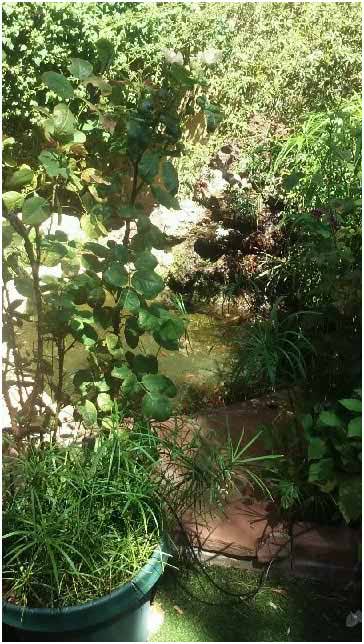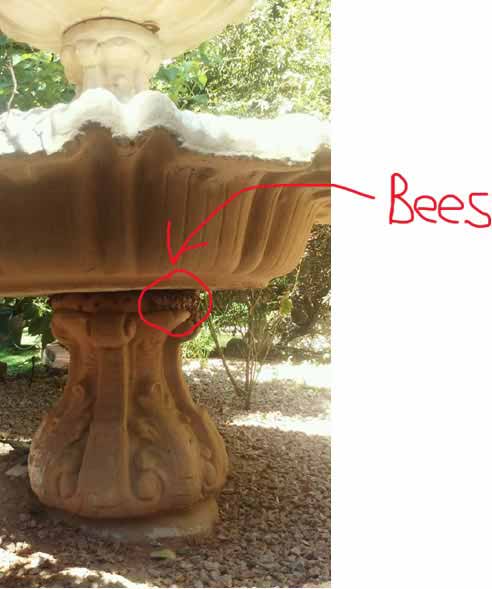
Bees at Fish Pond in Mesa, AZ
We were recently called by a homeowner to help with Bees at a Fish Pond in <a href=”https://azbeeremoval.com/cities-we-serve/southeast-valley-cities/mesa-bee-removal/”>Mesa, AZ</a> with so many bees that he could not enjoy his backyard sanctuary without the worry of getting stung. It is a common problem for bees to gather near water sources, such as swimming pools, ponds, waterfalls and other water features. Here is the fish pond.

A customer in Mesa, AZ reported a problem with bees at his fish pond[/caption]
Why Do Bees Gather Near a Water Source?
During the hot Summer months, particularly here in Mesa, Arizona and the surrounding area, we get a lot of calls about bees gathering water at swimming pools, waterfalls, fish ponds and other locations. Like most other living creatures, bees need water to survive. Bees use water to cool their hive and to hydrate. Bees also need water to raise brood (babies). To cool their hive, bees drink water at the water source, take it back to their hive, regurgitate the water, and spread it across the surface of their honeycomb. Other bees fan their wings causing the water to evaporate. This spreading and evaporation of water acts just like an evaporative cooler (aka swamp cooler) and helps the bees regulate the temperature of the hive at approximately 97 degrees Fahrenheit. Back to our story…
Upon arrival to the customer’s home, we observed a lot of bees gathering water around the edge of the backyard fish pond. We also noticed that there were fish in the pond. Specifically, they were Japanese Koi fish, which can cost a couple of hundred to a couple thousand dollars each if they are large. We have developed a proprietary method of keeping bees from most water sources if they are bothering people or pets. Unfortunately, it is not viable around fish.
Locating the Bee Hive
The number of bees gathering water from the pond was so large that we suspected that a beehive may be located nearby. We searched for a beehive all around the pond and landscaping in the area. Eventually, we noticed a dried-up fountain (bird bath) located about 20 feet from the pond that had some bee activity around it. See the photograph below the see the fountain. Closer inspection revealed that bees were gathered near the lower portion of the fountain. It turned out that bees had nested in the pedestal of the fountain just below the lower water bowl.
Bee Removal Options
Live Bee Removal
One way to remove the bees without killing them would be to disassemble the fountain and capture the bees in a vacuum. Saving the bees by performing a “live removal” is our specialty. Live removal would need to be completed between sunset and sunrise to prevent the bees from becoming agitated and potentially causing a bee-sting incident. Due to the size and weight of the fountain, disassembly would require two strong technicians. These factors elevated the cost above our customer’s desired budget; therefore, we were asked for a less expensive alternative.
Bee Extermination
In this situation, a less expensive alternative may be to exterminate the bees. This is not our first choice, but due to the circumstances it was considered due to the customer’s wishes. However, there was still one problem: fish in the pond. Virtually all pesticides are toxic to most fish species. It is highly likely that if we sprayed the bees at the fountain during the daylight hours, some pesticide-laced bees would fly away and fall into the pond as they died. If the fish saw these bees on the water surface, they would probably interpret them as a juicy snack and eat them. That could poison the fish. We didn’t want to risk poisoning the fish, so we proposed to exterminate the bees at night. Bees generally do not fly at night, so we would not have a problem with them flying away and dropping into the pond.
Did Our Customer Choose Live Bee Removal or Extermination?
Our customer agreed with our recommendation and price. So, we returned later that evening and exterminated the bees. Everything went per plan. Dying bees did not fly away, so there were no contaminated bees falling into the pond. He got his sanctuary back from the bees who had taken over the area surrounding the pond. No pesticide contacted the water, keeping the fish safe. Problem solved….mostly. The honeycomb remaining inside the base of the fountain could be a source for re-infestation, but that was a risk our customer was willing to take to save money.
How to find the Bee Removal Solution that’s Right for You.
Finding the right solution requires an experienced technician who has the support and supervision of master beekeepers who have over 20 years of experience keeping honey bees and removing honey bees; The Beekeeper Total Bee Control Inc. has the needed experience. If you have a similar problem or any other problem with bees or wasps and you live in Mesa, Arizona or a neighboring community, call The Beekeeper Total Bee Control and we will provide a free inspection and a written cost estimate.

